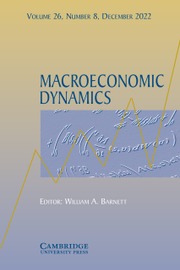No CrossRef data available.
Article contents
Optimal monetary policy with a risk-averse central bank
Published online by Cambridge University Press: 12 August 2025
Abstract
Within a new Keynesian model of monetary policy with both backward- and forward-looking variables, we investigate the impact of risk aversion by assuming that the central bank is endowed with recursive preferences à la Hansen and Sargent (Hansen and Sargent, 1995). We establish that, since in this model inflation and output are forward-looking, under discretion the optimal policy is found by solving two distinct fixed-point problems: the former pertains to the central bank’s optimization exercise, the latter to the identification of the equilibrium expectations of the forward-looking variables. We show that, in the presence of forward-looking variables, the optimal policy differs from the robust policy chosen by a central bank endowed with quadratic preferences and subject to Knightian uncertainty, confuting the equivalence established by Hansen and Sargent (2008) when only backward-looking variables enter into the laws of motion regulating the dynamics of the economic system. Through our analysis we show: i) how a risk-averse central bank selects a more aggressive policy than one furnished with the standard preferences of a canonical DSGE model; ii) that the “divine coincidence” established within traditional linear-quadratic formulations between inflation and output stabilization no longer holds.
Information
- Type
- Articles
- Information
- Copyright
- © The Author(s), 2025. Published by Cambridge University Press

